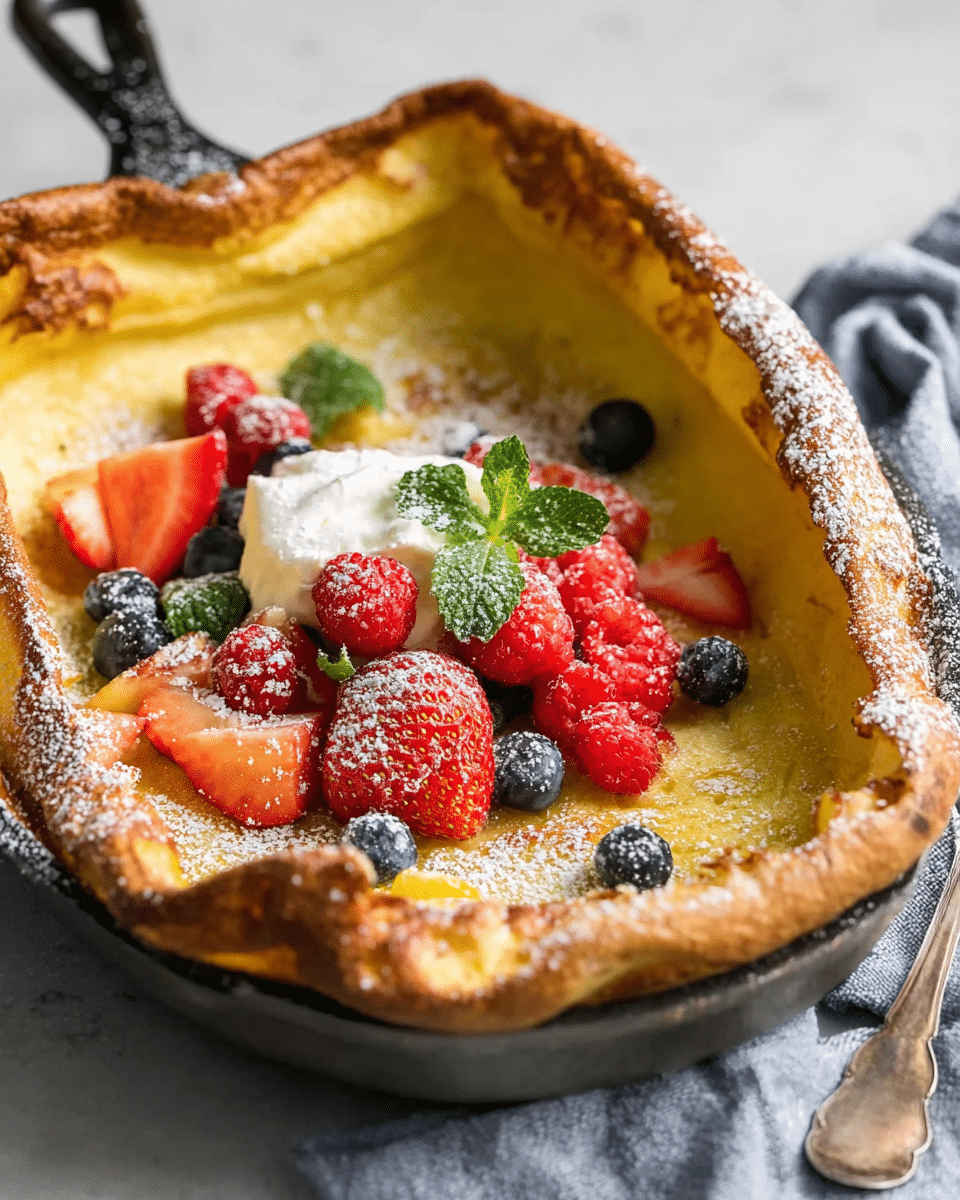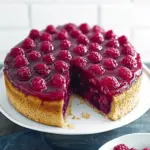This easy Dutch Baby Pancake, also known as a German pancake, is a delicious and light breakfast option. Made with just a few simple ingredients, this dish puffs up beautifully in the oven, creating a golden, airy pancake that’s perfect for topping with fresh fruits and a dusting of powdered sugar. It’s a quick and impressive breakfast that requires minimal effort but yields amazing results.
Full Recipe:
Ingredients
-
6 tbsp unsalted butter, cubed
-
1 cup milk (room temperature)
-
6 eggs (room temperature)
-
1/2 tsp salt
-
1 tbsp sugar
-
1 tbsp vanilla extract
-
1 cup all-purpose flour (do not use self-rising flour)
-
Toppings:
-
Powdered sugar (optional)
-
Lemon juice (optional)
-
Whipped cream (optional)
-
Fresh fruit of choice (e.g., strawberries, blueberries)
-
Directions
-
Preheat the oven to 425°F. Add the cubed butter to a 9×13-inch baking dish and bake for 5 minutes, or until the butter is golden brown.
-
In a blender, food processor, or with a hand mixer, combine the milk, eggs, salt, sugar, vanilla extract, and flour. Mix on low for about 20 seconds until the batter is smooth with no lumps. Let the batter sit for 5 minutes.
-
Once the butter is melted and golden brown, carefully swirl the pan to coat the sides with the butter. Pour the batter into the hot pan, then bake for 18-20 minutes.
-
After baking, the pancake will puff up but may deflate a little once out of the oven.
-
Serve immediately with powdered sugar, fresh lemon juice, whipped cream, and your favorite fresh fruits.
Nutrients
-
Calories: 214 kcal
-
Carbohydrates: 17g
-
Protein: 7g
-
Fat: 13g
-
Saturated Fat: 7g
-
Trans Fat: 1g
-
Cholesterol: 148mg
-
Sodium: 207mg
-
Potassium: 135mg
-
Fiber: 1g
-
Sugar: 4g
-
Vitamin A: 492 IU
-
Vitamin C: 11mg
-
Calcium: 61mg
-
Iron: 1mg
The History Behind the Dutch Baby Pancake
The Dutch Baby Pancake has a fascinating history that traces back to the early 1900s. Although the name “Dutch Baby” sounds like it could be linked to Dutch cuisine, it was actually created in the United States. The story goes that the pancake was invented by a German immigrant family in the Pacific Northwest. The mother of the family is said to have made a unique oven-baked pancake, which she referred to as a “Dutch” pancake, due to the influence of their German roots. Over time, the name was changed to “Dutch Baby,” possibly due to a mix-up in translation or as a term of endearment. The dish quickly gained popularity for its simplicity and dramatic presentation, often served in the cast-iron skillet in which it was baked.
The Charm of the Dutch Baby Pancake
What sets the Dutch Baby Pancake apart from traditional pancakes is its texture. When baked, the pancake puffs up dramatically, creating a fluffy, almost soufflé-like texture that is both airy and substantial. The outer edges of the pancake become golden and slightly crisp, while the center remains soft and tender. This contrast in textures adds an extra dimension to the eating experience. Unlike other pancakes that require flipping and constant attention, a Dutch Baby Pancake requires minimal hands-on time, making it an ideal option for a leisurely breakfast.
The Ingredients: Simple Yet Flavorful
A Dutch Baby Pancake is made with a handful of basic ingredients that you probably already have in your kitchen. The beauty of this recipe lies in its simplicity, allowing the flavors to shine through without the need for complicated steps or exotic ingredients. The key ingredients are eggs, milk, flour, sugar, vanilla extract, and butter. The eggs and milk create a rich, custardy texture, while the flour provides structure. Sugar and vanilla add a hint of sweetness, which is perfect for balancing the richness of the butter. The batter comes together quickly and easily, making it a stress-free breakfast option.
Baking the Dutch Baby Pancake
Baking the Dutch Baby Pancake is where the magic happens. The batter is poured into a hot, buttered baking dish, and the heat from the oven causes the pancake to puff up dramatically. The butter is essential for both flavor and texture. As the butter melts and browns in the hot dish, it infuses the pancake with a rich, slightly nutty flavor that elevates the overall taste. The baking process also causes the edges to crisp up, giving the pancake its signature texture. It is important to bake the pancake at a high temperature, usually around 425°F (220°C), to ensure that it puffs up properly. The pancake will rise during the first few minutes in the oven and then slowly deflate after being removed, which is completely normal. The deflation doesn’t affect the taste, and the pancake remains deliciously soft and airy.
Serving the Dutch Baby Pancake
One of the most exciting aspects of a Dutch Baby Pancake is how versatile it is when it comes to toppings. You can customize it based on your personal preferences, creating a unique breakfast each time you bake it. Some popular toppings include fresh fruit, such as strawberries, blueberries, or bananas. A dusting of powdered sugar adds a sweet touch, while a squeeze of fresh lemon juice enhances the flavor with a bit of brightness. Whipped cream can also be a luxurious addition, adding richness and decadence to the dish. You can also try other toppings like maple syrup, honey, or even a sprinkle of cinnamon for an extra layer of flavor.
Health Benefits of the Dutch Baby Pancake
Though the Dutch Baby Pancake is certainly indulgent, it can be made healthier with a few adjustments. The eggs and milk provide protein and calcium, which are essential for maintaining strong bones and muscles. The pancake also contains a fair amount of healthy fats from the butter, which can be beneficial in moderation. If you’re looking to make the dish lighter, you could try using less butter or substituting some of the all-purpose flour with whole wheat flour. Additionally, topping the pancake with fresh fruit is a great way to boost the nutritional value, adding vitamins, fiber, and antioxidants to your meal.
Tips for Making the Perfect Dutch Baby Pancake
To ensure your Dutch Baby Pancake turns out perfectly every time, here are a few helpful tips:
-
Use Room Temperature Ingredients: For the best texture, it’s important that your eggs and milk are at room temperature. Cold ingredients can cause the batter to seize up and may affect the pancake’s puffiness.
-
Preheat the Baking Dish: The butter should be melted and bubbling in the baking dish before the batter is added. This helps the pancake to rise and gives it a crispy edge.
-
Don’t Open the Oven Door: While the pancake is baking, try to resist the urge to open the oven door. The Dutch Baby needs the consistent heat to rise properly, and opening the door can cause it to deflate prematurely.
-
Serve Immediately: A Dutch Baby Pancake is best served right out of the oven, as it can lose its puffed-up texture over time.
Why You Should Add the Dutch Baby Pancake to Your Breakfast Routine
The Dutch Baby Pancake is the perfect blend of simplicity and elegance, making it a great option for a special breakfast or brunch. Whether you’re looking for an impressive dish to serve guests or a simple yet delicious meal for your family, this pancake delivers. It’s quick to prepare, easy to customize, and sure to impress with its dramatic puff and delectable taste. Whether you enjoy it with fresh fruit, a dusting of powdered sugar, or a dollop of whipped cream, the Dutch Baby Pancake is an indulgent breakfast that can be made without much fuss.
Conclusion
The Dutch Baby Pancake is a breakfast classic that combines the best of both worlds: simplicity and sophistication. With its delicate, airy texture and golden, crispy edges, it’s a dish that not only looks impressive but tastes incredible. It’s versatile enough to be topped with an array of fruits, syrups, and creams, making it a dish that can be tailored to suit any palate. Whether you’re looking to impress guests, treat yourself, or feed the family, the Dutch Baby Pancake is a delicious option that’s easy to make and sure to delight. Try it out next time you’re in the mood for something new and exciting for breakfast—it’s a dish that’s bound to become a favorite!






